Surgical Patient Case Study: Clinical Reasoning Cycle Analysis
VerifiedAdded on 2022/07/28
|10
|2643
|45
Case Study
AI Summary
This assignment presents a detailed analysis of a surgical case study, focusing on the application of the clinical reasoning cycle. The case involves an 84-year-old male patient, Ted, who is four days post-bowel resection with a temporary colostomy. The assignment addresses the biopsychosocial, spiritual, and cultural impacts of the surgery on the patient and his family, including the effects on healing and potential complications. It then proceeds to process patient information, including symptoms like vomiting, nausea, abdominal distension, and elevated temperature, along with relevant vital signs and lab values. Problem identification involves recognizing potential complications such as bowel obstruction, intestinal necrosis, and stoma infection, considering factors like diet resumption, sluggish bowel sounds, and the patient's pre-existing conditions like heart failure and diabetes. The assignment outlines care goals and nursing interventions, including intravenous fluid administration, nasogastric tube insertion, ambulation, and monitoring vital signs and lab values. Specific drug classes, including antibiotics (ceftriaxone) and analgesics (morphine), are discussed, along with their mechanisms of action, expected side effects, and nursing considerations. The assignment emphasizes the importance of prompt action to relieve obstruction, manage pain, and prevent infection to improve the patient's condition. The paper is well-structured and supported by relevant literature, demonstrating a thorough understanding of the clinical reasoning process in a surgical setting.
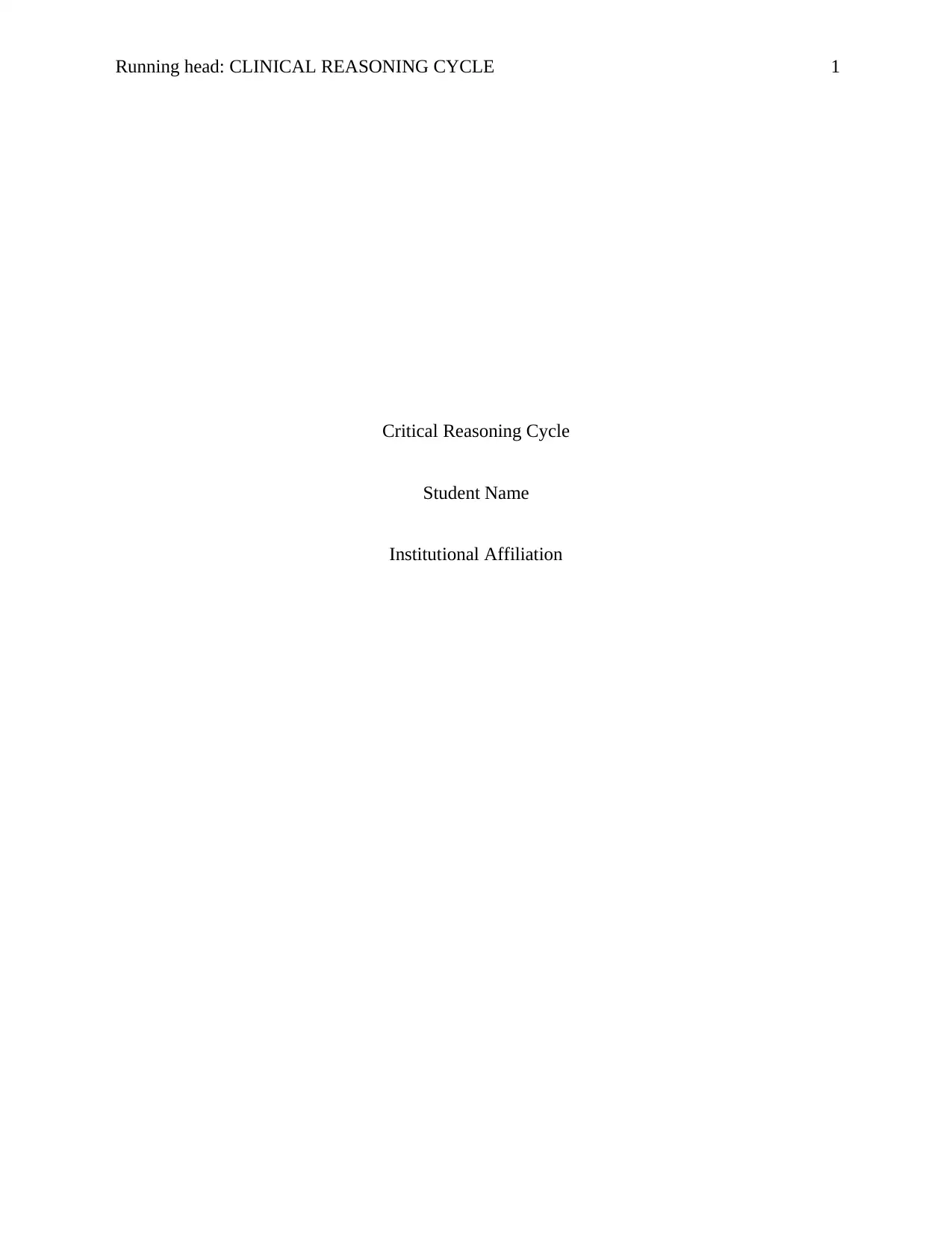
Running head: CLINICAL REASONING CYCLE 1
Critical Reasoning Cycle
Student Name
Institutional Affiliation
Critical Reasoning Cycle
Student Name
Institutional Affiliation
Paraphrase This Document
Need a fresh take? Get an instant paraphrase of this document with our AI Paraphraser
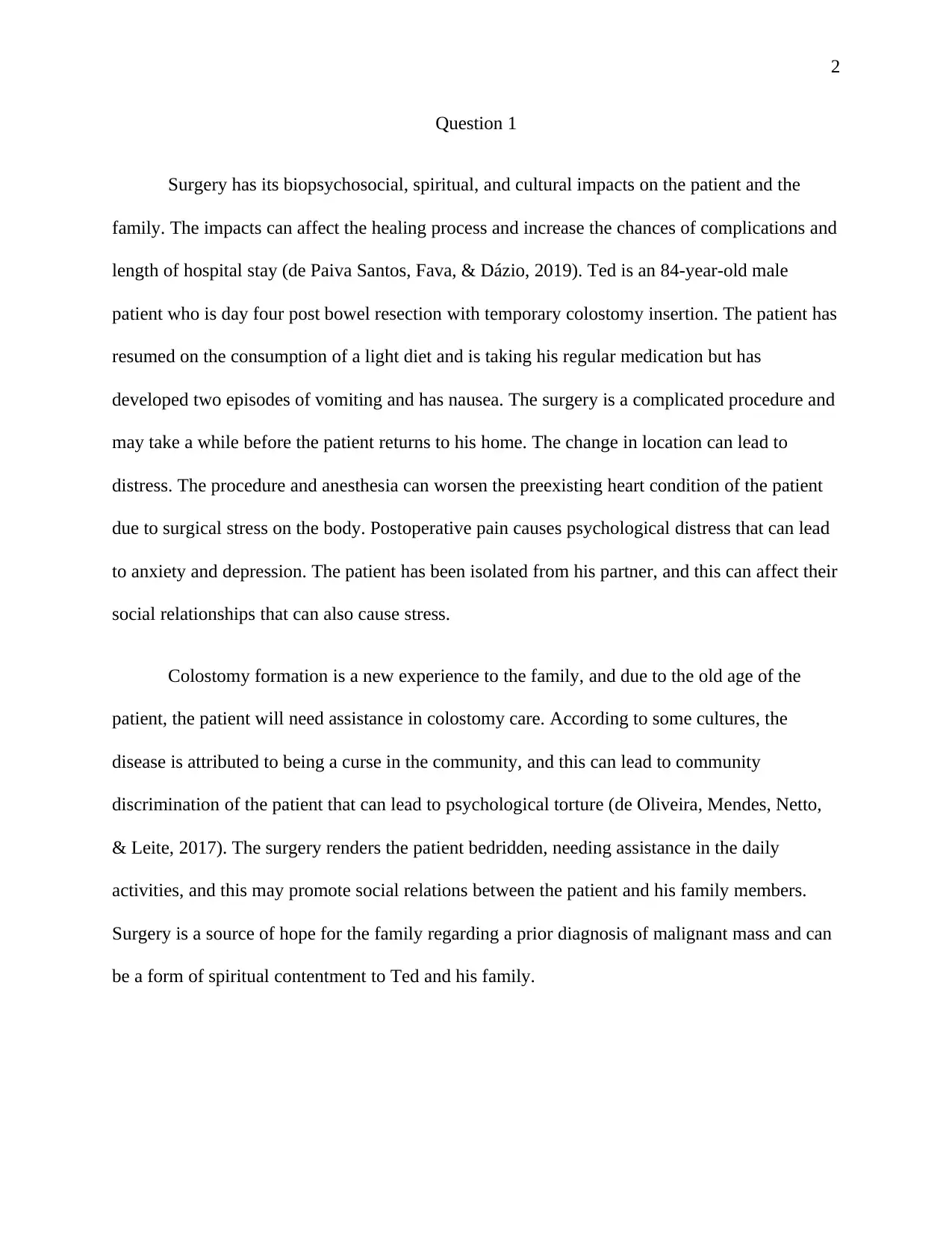
2
Question 1
Surgery has its biopsychosocial, spiritual, and cultural impacts on the patient and the
family. The impacts can affect the healing process and increase the chances of complications and
length of hospital stay (de Paiva Santos, Fava, & Dázio, 2019). Ted is an 84-year-old male
patient who is day four post bowel resection with temporary colostomy insertion. The patient has
resumed on the consumption of a light diet and is taking his regular medication but has
developed two episodes of vomiting and has nausea. The surgery is a complicated procedure and
may take a while before the patient returns to his home. The change in location can lead to
distress. The procedure and anesthesia can worsen the preexisting heart condition of the patient
due to surgical stress on the body. Postoperative pain causes psychological distress that can lead
to anxiety and depression. The patient has been isolated from his partner, and this can affect their
social relationships that can also cause stress.
Colostomy formation is a new experience to the family, and due to the old age of the
patient, the patient will need assistance in colostomy care. According to some cultures, the
disease is attributed to being a curse in the community, and this can lead to community
discrimination of the patient that can lead to psychological torture (de Oliveira, Mendes, Netto,
& Leite, 2017). The surgery renders the patient bedridden, needing assistance in the daily
activities, and this may promote social relations between the patient and his family members.
Surgery is a source of hope for the family regarding a prior diagnosis of malignant mass and can
be a form of spiritual contentment to Ted and his family.
Question 1
Surgery has its biopsychosocial, spiritual, and cultural impacts on the patient and the
family. The impacts can affect the healing process and increase the chances of complications and
length of hospital stay (de Paiva Santos, Fava, & Dázio, 2019). Ted is an 84-year-old male
patient who is day four post bowel resection with temporary colostomy insertion. The patient has
resumed on the consumption of a light diet and is taking his regular medication but has
developed two episodes of vomiting and has nausea. The surgery is a complicated procedure and
may take a while before the patient returns to his home. The change in location can lead to
distress. The procedure and anesthesia can worsen the preexisting heart condition of the patient
due to surgical stress on the body. Postoperative pain causes psychological distress that can lead
to anxiety and depression. The patient has been isolated from his partner, and this can affect their
social relationships that can also cause stress.
Colostomy formation is a new experience to the family, and due to the old age of the
patient, the patient will need assistance in colostomy care. According to some cultures, the
disease is attributed to being a curse in the community, and this can lead to community
discrimination of the patient that can lead to psychological torture (de Oliveira, Mendes, Netto,
& Leite, 2017). The surgery renders the patient bedridden, needing assistance in the daily
activities, and this may promote social relations between the patient and his family members.
Surgery is a source of hope for the family regarding a prior diagnosis of malignant mass and can
be a form of spiritual contentment to Ted and his family.
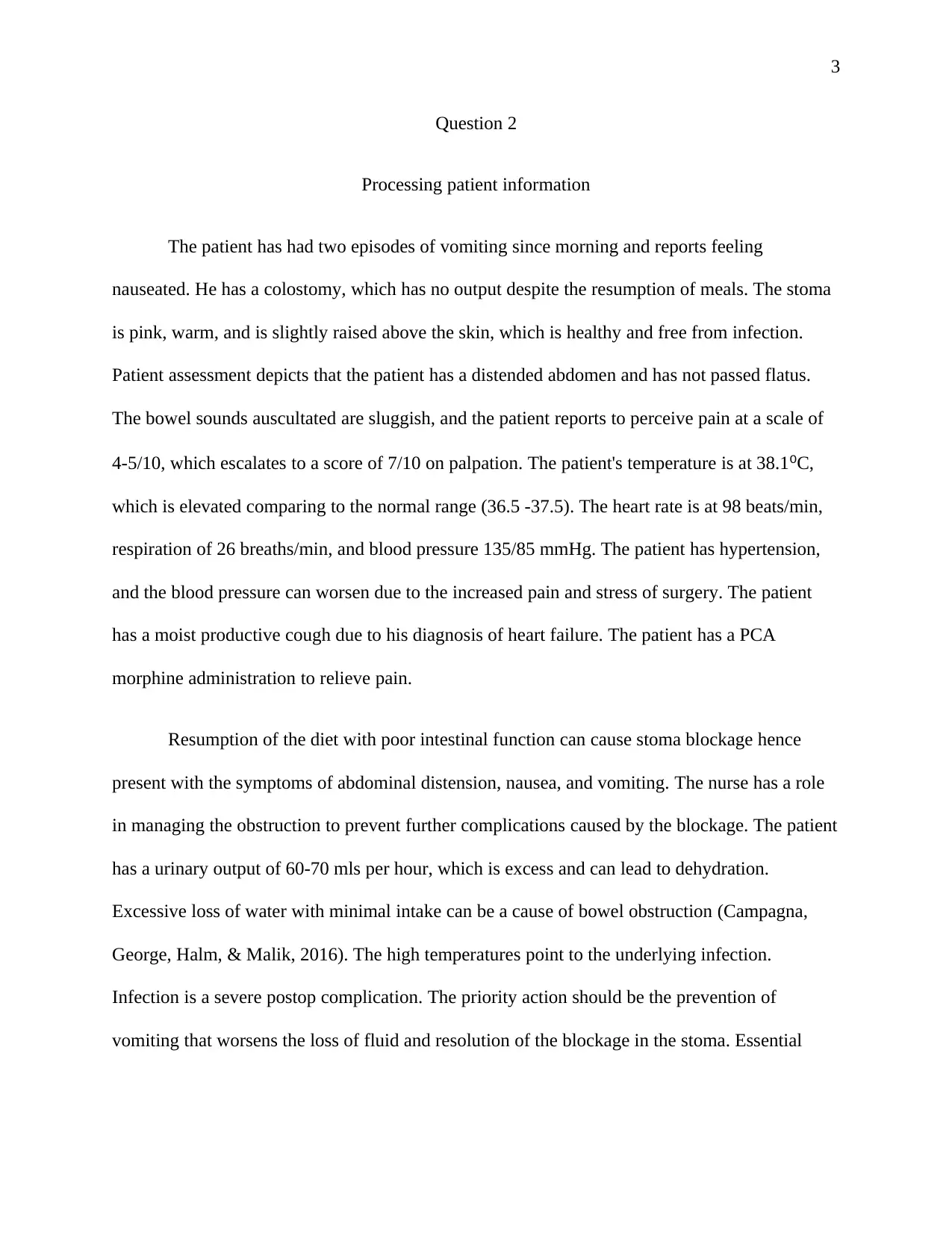
3
Question 2
Processing patient information
The patient has had two episodes of vomiting since morning and reports feeling
nauseated. He has a colostomy, which has no output despite the resumption of meals. The stoma
is pink, warm, and is slightly raised above the skin, which is healthy and free from infection.
Patient assessment depicts that the patient has a distended abdomen and has not passed flatus.
The bowel sounds auscultated are sluggish, and the patient reports to perceive pain at a scale of
4-5/10, which escalates to a score of 7/10 on palpation. The patient's temperature is at 38.1⁰C,
which is elevated comparing to the normal range (36.5 -37.5). The heart rate is at 98 beats/min,
respiration of 26 breaths/min, and blood pressure 135/85 mmHg. The patient has hypertension,
and the blood pressure can worsen due to the increased pain and stress of surgery. The patient
has a moist productive cough due to his diagnosis of heart failure. The patient has a PCA
morphine administration to relieve pain.
Resumption of the diet with poor intestinal function can cause stoma blockage hence
present with the symptoms of abdominal distension, nausea, and vomiting. The nurse has a role
in managing the obstruction to prevent further complications caused by the blockage. The patient
has a urinary output of 60-70 mls per hour, which is excess and can lead to dehydration.
Excessive loss of water with minimal intake can be a cause of bowel obstruction (Campagna,
George, Halm, & Malik, 2016). The high temperatures point to the underlying infection.
Infection is a severe postop complication. The priority action should be the prevention of
vomiting that worsens the loss of fluid and resolution of the blockage in the stoma. Essential
Question 2
Processing patient information
The patient has had two episodes of vomiting since morning and reports feeling
nauseated. He has a colostomy, which has no output despite the resumption of meals. The stoma
is pink, warm, and is slightly raised above the skin, which is healthy and free from infection.
Patient assessment depicts that the patient has a distended abdomen and has not passed flatus.
The bowel sounds auscultated are sluggish, and the patient reports to perceive pain at a scale of
4-5/10, which escalates to a score of 7/10 on palpation. The patient's temperature is at 38.1⁰C,
which is elevated comparing to the normal range (36.5 -37.5). The heart rate is at 98 beats/min,
respiration of 26 breaths/min, and blood pressure 135/85 mmHg. The patient has hypertension,
and the blood pressure can worsen due to the increased pain and stress of surgery. The patient
has a moist productive cough due to his diagnosis of heart failure. The patient has a PCA
morphine administration to relieve pain.
Resumption of the diet with poor intestinal function can cause stoma blockage hence
present with the symptoms of abdominal distension, nausea, and vomiting. The nurse has a role
in managing the obstruction to prevent further complications caused by the blockage. The patient
has a urinary output of 60-70 mls per hour, which is excess and can lead to dehydration.
Excessive loss of water with minimal intake can be a cause of bowel obstruction (Campagna,
George, Halm, & Malik, 2016). The high temperatures point to the underlying infection.
Infection is a severe postop complication. The priority action should be the prevention of
vomiting that worsens the loss of fluid and resolution of the blockage in the stoma. Essential
⊘ This is a preview!⊘
Do you want full access?
Subscribe today to unlock all pages.

Trusted by 1+ million students worldwide
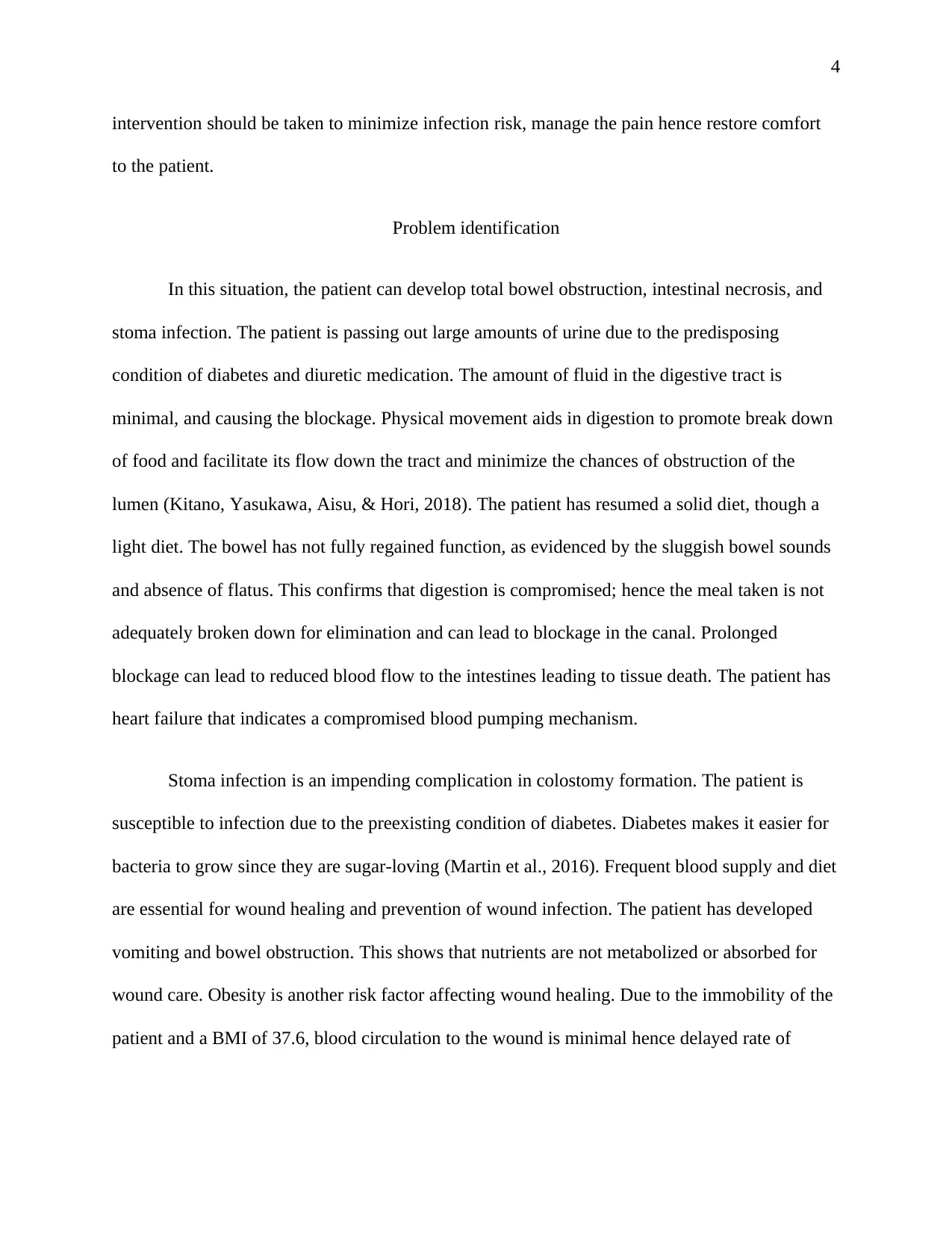
4
intervention should be taken to minimize infection risk, manage the pain hence restore comfort
to the patient.
Problem identification
In this situation, the patient can develop total bowel obstruction, intestinal necrosis, and
stoma infection. The patient is passing out large amounts of urine due to the predisposing
condition of diabetes and diuretic medication. The amount of fluid in the digestive tract is
minimal, and causing the blockage. Physical movement aids in digestion to promote break down
of food and facilitate its flow down the tract and minimize the chances of obstruction of the
lumen (Kitano, Yasukawa, Aisu, & Hori, 2018). The patient has resumed a solid diet, though a
light diet. The bowel has not fully regained function, as evidenced by the sluggish bowel sounds
and absence of flatus. This confirms that digestion is compromised; hence the meal taken is not
adequately broken down for elimination and can lead to blockage in the canal. Prolonged
blockage can lead to reduced blood flow to the intestines leading to tissue death. The patient has
heart failure that indicates a compromised blood pumping mechanism.
Stoma infection is an impending complication in colostomy formation. The patient is
susceptible to infection due to the preexisting condition of diabetes. Diabetes makes it easier for
bacteria to grow since they are sugar-loving (Martin et al., 2016). Frequent blood supply and diet
are essential for wound healing and prevention of wound infection. The patient has developed
vomiting and bowel obstruction. This shows that nutrients are not metabolized or absorbed for
wound care. Obesity is another risk factor affecting wound healing. Due to the immobility of the
patient and a BMI of 37.6, blood circulation to the wound is minimal hence delayed rate of
intervention should be taken to minimize infection risk, manage the pain hence restore comfort
to the patient.
Problem identification
In this situation, the patient can develop total bowel obstruction, intestinal necrosis, and
stoma infection. The patient is passing out large amounts of urine due to the predisposing
condition of diabetes and diuretic medication. The amount of fluid in the digestive tract is
minimal, and causing the blockage. Physical movement aids in digestion to promote break down
of food and facilitate its flow down the tract and minimize the chances of obstruction of the
lumen (Kitano, Yasukawa, Aisu, & Hori, 2018). The patient has resumed a solid diet, though a
light diet. The bowel has not fully regained function, as evidenced by the sluggish bowel sounds
and absence of flatus. This confirms that digestion is compromised; hence the meal taken is not
adequately broken down for elimination and can lead to blockage in the canal. Prolonged
blockage can lead to reduced blood flow to the intestines leading to tissue death. The patient has
heart failure that indicates a compromised blood pumping mechanism.
Stoma infection is an impending complication in colostomy formation. The patient is
susceptible to infection due to the preexisting condition of diabetes. Diabetes makes it easier for
bacteria to grow since they are sugar-loving (Martin et al., 2016). Frequent blood supply and diet
are essential for wound healing and prevention of wound infection. The patient has developed
vomiting and bowel obstruction. This shows that nutrients are not metabolized or absorbed for
wound care. Obesity is another risk factor affecting wound healing. Due to the immobility of the
patient and a BMI of 37.6, blood circulation to the wound is minimal hence delayed rate of
Paraphrase This Document
Need a fresh take? Get an instant paraphrase of this document with our AI Paraphraser
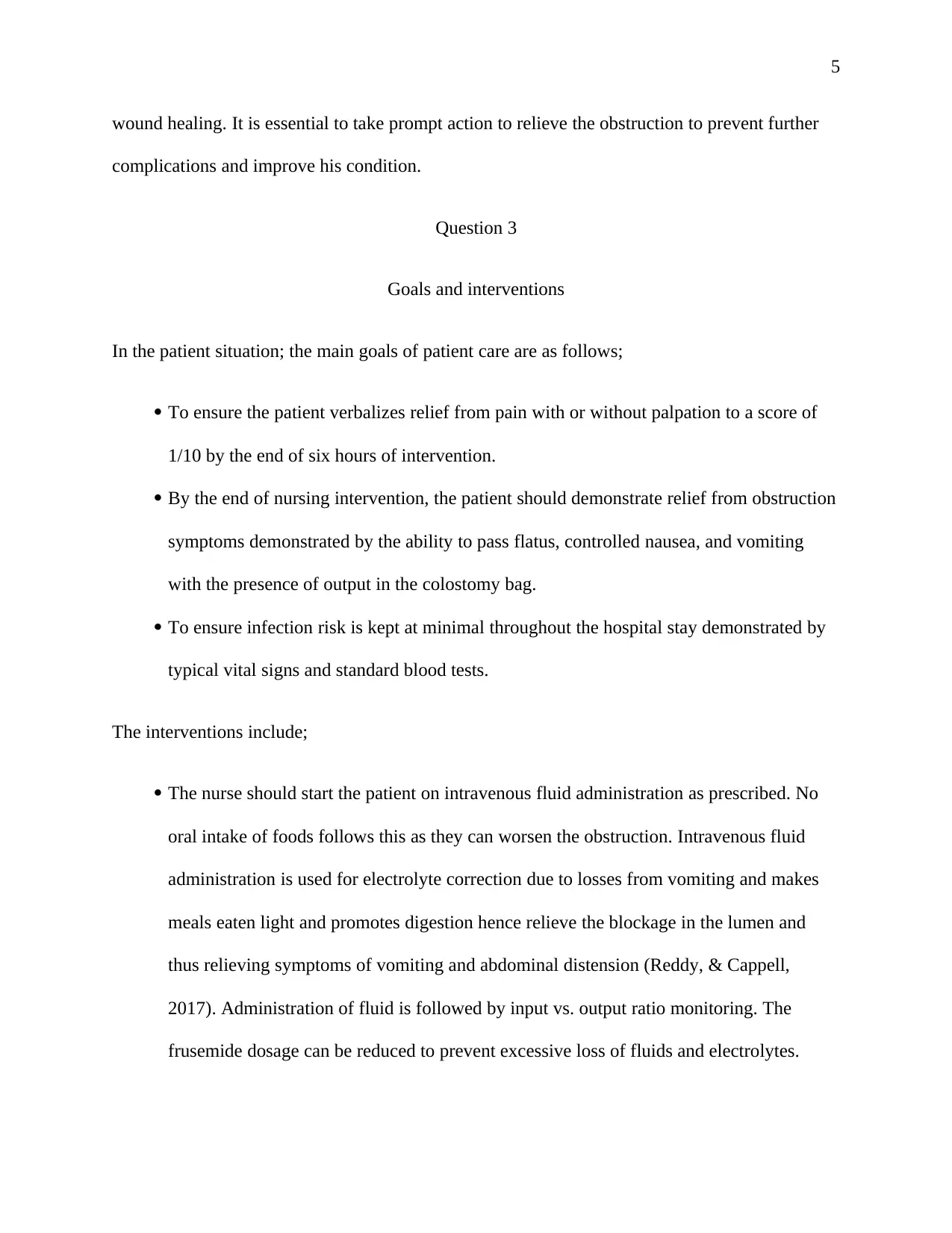
5
wound healing. It is essential to take prompt action to relieve the obstruction to prevent further
complications and improve his condition.
Question 3
Goals and interventions
In the patient situation; the main goals of patient care are as follows;
To ensure the patient verbalizes relief from pain with or without palpation to a score of
1/10 by the end of six hours of intervention.
By the end of nursing intervention, the patient should demonstrate relief from obstruction
symptoms demonstrated by the ability to pass flatus, controlled nausea, and vomiting
with the presence of output in the colostomy bag.
To ensure infection risk is kept at minimal throughout the hospital stay demonstrated by
typical vital signs and standard blood tests.
The interventions include;
The nurse should start the patient on intravenous fluid administration as prescribed. No
oral intake of foods follows this as they can worsen the obstruction. Intravenous fluid
administration is used for electrolyte correction due to losses from vomiting and makes
meals eaten light and promotes digestion hence relieve the blockage in the lumen and
thus relieving symptoms of vomiting and abdominal distension (Reddy, & Cappell,
2017). Administration of fluid is followed by input vs. output ratio monitoring. The
frusemide dosage can be reduced to prevent excessive loss of fluids and electrolytes.
wound healing. It is essential to take prompt action to relieve the obstruction to prevent further
complications and improve his condition.
Question 3
Goals and interventions
In the patient situation; the main goals of patient care are as follows;
To ensure the patient verbalizes relief from pain with or without palpation to a score of
1/10 by the end of six hours of intervention.
By the end of nursing intervention, the patient should demonstrate relief from obstruction
symptoms demonstrated by the ability to pass flatus, controlled nausea, and vomiting
with the presence of output in the colostomy bag.
To ensure infection risk is kept at minimal throughout the hospital stay demonstrated by
typical vital signs and standard blood tests.
The interventions include;
The nurse should start the patient on intravenous fluid administration as prescribed. No
oral intake of foods follows this as they can worsen the obstruction. Intravenous fluid
administration is used for electrolyte correction due to losses from vomiting and makes
meals eaten light and promotes digestion hence relieve the blockage in the lumen and
thus relieving symptoms of vomiting and abdominal distension (Reddy, & Cappell,
2017). Administration of fluid is followed by input vs. output ratio monitoring. The
frusemide dosage can be reduced to prevent excessive loss of fluids and electrolytes.
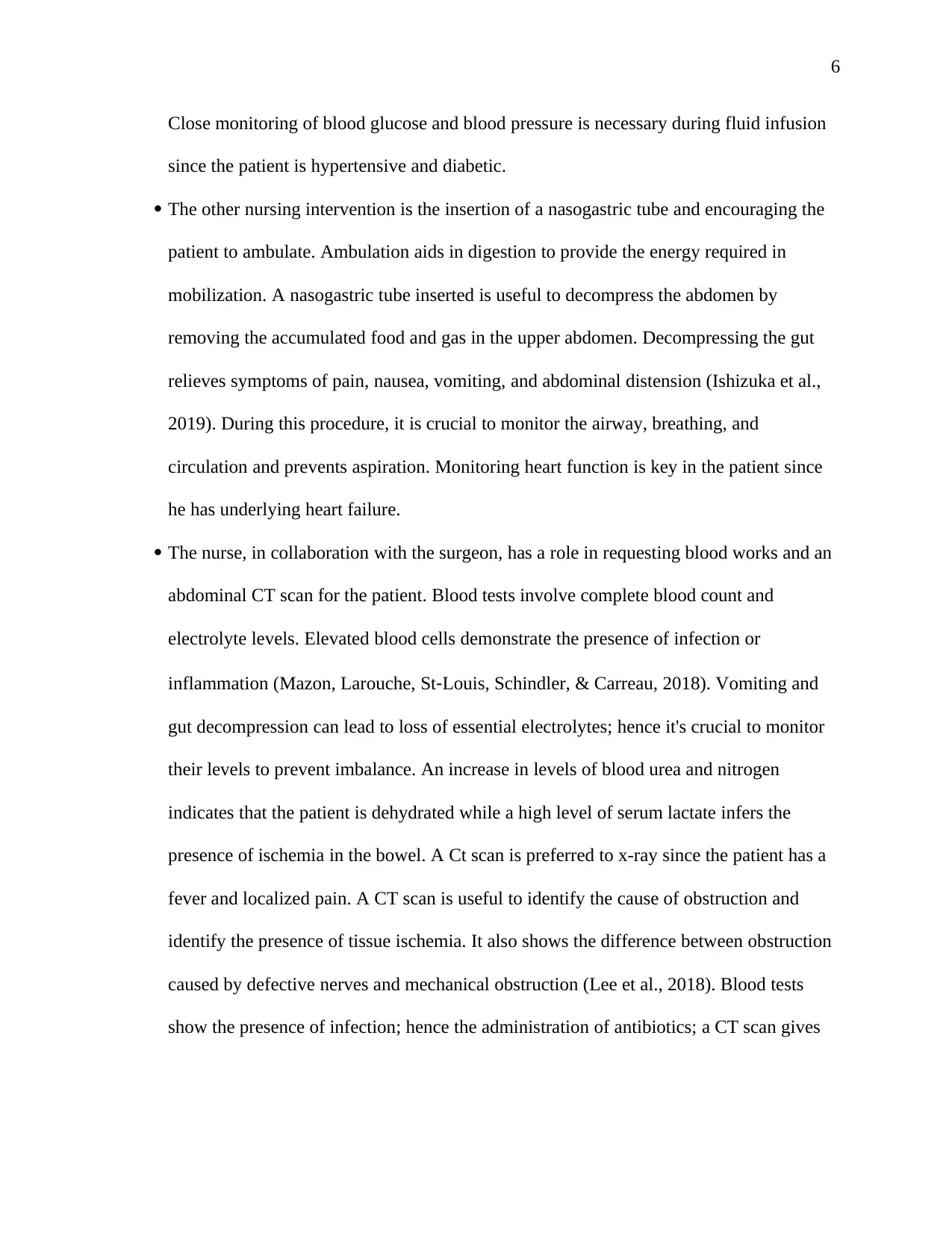
6
Close monitoring of blood glucose and blood pressure is necessary during fluid infusion
since the patient is hypertensive and diabetic.
The other nursing intervention is the insertion of a nasogastric tube and encouraging the
patient to ambulate. Ambulation aids in digestion to provide the energy required in
mobilization. A nasogastric tube inserted is useful to decompress the abdomen by
removing the accumulated food and gas in the upper abdomen. Decompressing the gut
relieves symptoms of pain, nausea, vomiting, and abdominal distension (Ishizuka et al.,
2019). During this procedure, it is crucial to monitor the airway, breathing, and
circulation and prevents aspiration. Monitoring heart function is key in the patient since
he has underlying heart failure.
The nurse, in collaboration with the surgeon, has a role in requesting blood works and an
abdominal CT scan for the patient. Blood tests involve complete blood count and
electrolyte levels. Elevated blood cells demonstrate the presence of infection or
inflammation (Mazon, Larouche, St‐Louis, Schindler, & Carreau, 2018). Vomiting and
gut decompression can lead to loss of essential electrolytes; hence it's crucial to monitor
their levels to prevent imbalance. An increase in levels of blood urea and nitrogen
indicates that the patient is dehydrated while a high level of serum lactate infers the
presence of ischemia in the bowel. A Ct scan is preferred to x-ray since the patient has a
fever and localized pain. A CT scan is useful to identify the cause of obstruction and
identify the presence of tissue ischemia. It also shows the difference between obstruction
caused by defective nerves and mechanical obstruction (Lee et al., 2018). Blood tests
show the presence of infection; hence the administration of antibiotics; a CT scan gives
Close monitoring of blood glucose and blood pressure is necessary during fluid infusion
since the patient is hypertensive and diabetic.
The other nursing intervention is the insertion of a nasogastric tube and encouraging the
patient to ambulate. Ambulation aids in digestion to provide the energy required in
mobilization. A nasogastric tube inserted is useful to decompress the abdomen by
removing the accumulated food and gas in the upper abdomen. Decompressing the gut
relieves symptoms of pain, nausea, vomiting, and abdominal distension (Ishizuka et al.,
2019). During this procedure, it is crucial to monitor the airway, breathing, and
circulation and prevents aspiration. Monitoring heart function is key in the patient since
he has underlying heart failure.
The nurse, in collaboration with the surgeon, has a role in requesting blood works and an
abdominal CT scan for the patient. Blood tests involve complete blood count and
electrolyte levels. Elevated blood cells demonstrate the presence of infection or
inflammation (Mazon, Larouche, St‐Louis, Schindler, & Carreau, 2018). Vomiting and
gut decompression can lead to loss of essential electrolytes; hence it's crucial to monitor
their levels to prevent imbalance. An increase in levels of blood urea and nitrogen
indicates that the patient is dehydrated while a high level of serum lactate infers the
presence of ischemia in the bowel. A Ct scan is preferred to x-ray since the patient has a
fever and localized pain. A CT scan is useful to identify the cause of obstruction and
identify the presence of tissue ischemia. It also shows the difference between obstruction
caused by defective nerves and mechanical obstruction (Lee et al., 2018). Blood tests
show the presence of infection; hence the administration of antibiotics; a CT scan gives
⊘ This is a preview!⊘
Do you want full access?
Subscribe today to unlock all pages.

Trusted by 1+ million students worldwide

7
light to the management of the obstruction, whether conservative or surgical
management.
The nurse has a role in patient pain management. The patient has a PCA morphine in situ.
Dose changes can help relieve pain. The nurse can also encourage the patient to lift his
legs towards his abdomen and roll slightly from one side to another. This promotes
digestion, relieving abdominal pain (Morisawa et al., 2017). The nurse should also
monitor vital signs closely. Heart rate and blood pressure increase in cases of pain
perception. Uncontrolled blood pressure is risky for the patient with underlying heart
failure.
Prophylactic antibiotic therapy is a crucial intervention in the management of the patient.
The nurse should administer antibiotics to prevent cases of infection. The patient has a
fever, a BMI of 37.6, and is diabetic. Together with the broken skin, the patient has an
increased risk of infection. Antibiotics help in fighting microorganisms and can prevent
the entry of microbes and fight the present bacteria causing the fever. This will promote
wound healing and avoid stoma complications.
Question 4
Drugs classes
Antibiotics
Ted should be treated with antibiotics for prophylaxis against infection. The patient has a
fever, which is a key indicator of infection. The patient has a stoma which provides
communication to body organs, and the skin is broken. These are risks for an infection that can
lead to sepsis and delayed wound healing. An example of an antibiotic fit for Ted is ceftriaxone.
light to the management of the obstruction, whether conservative or surgical
management.
The nurse has a role in patient pain management. The patient has a PCA morphine in situ.
Dose changes can help relieve pain. The nurse can also encourage the patient to lift his
legs towards his abdomen and roll slightly from one side to another. This promotes
digestion, relieving abdominal pain (Morisawa et al., 2017). The nurse should also
monitor vital signs closely. Heart rate and blood pressure increase in cases of pain
perception. Uncontrolled blood pressure is risky for the patient with underlying heart
failure.
Prophylactic antibiotic therapy is a crucial intervention in the management of the patient.
The nurse should administer antibiotics to prevent cases of infection. The patient has a
fever, a BMI of 37.6, and is diabetic. Together with the broken skin, the patient has an
increased risk of infection. Antibiotics help in fighting microorganisms and can prevent
the entry of microbes and fight the present bacteria causing the fever. This will promote
wound healing and avoid stoma complications.
Question 4
Drugs classes
Antibiotics
Ted should be treated with antibiotics for prophylaxis against infection. The patient has a
fever, which is a key indicator of infection. The patient has a stoma which provides
communication to body organs, and the skin is broken. These are risks for an infection that can
lead to sepsis and delayed wound healing. An example of an antibiotic fit for Ted is ceftriaxone.
Paraphrase This Document
Need a fresh take? Get an instant paraphrase of this document with our AI Paraphraser
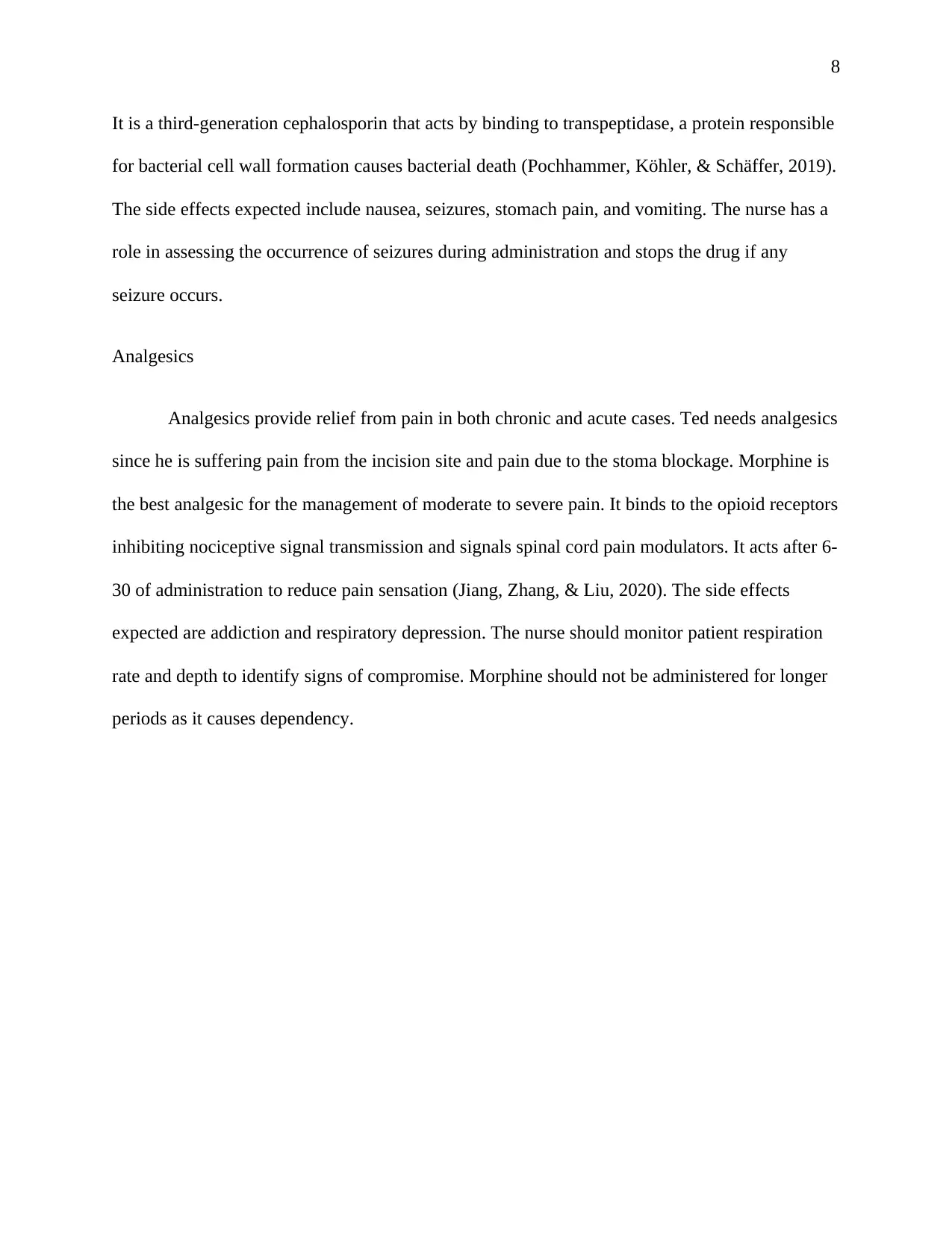
8
It is a third-generation cephalosporin that acts by binding to transpeptidase, a protein responsible
for bacterial cell wall formation causes bacterial death (Pochhammer, Köhler, & Schäffer, 2019).
The side effects expected include nausea, seizures, stomach pain, and vomiting. The nurse has a
role in assessing the occurrence of seizures during administration and stops the drug if any
seizure occurs.
Analgesics
Analgesics provide relief from pain in both chronic and acute cases. Ted needs analgesics
since he is suffering pain from the incision site and pain due to the stoma blockage. Morphine is
the best analgesic for the management of moderate to severe pain. It binds to the opioid receptors
inhibiting nociceptive signal transmission and signals spinal cord pain modulators. It acts after 6-
30 of administration to reduce pain sensation (Jiang, Zhang, & Liu, 2020). The side effects
expected are addiction and respiratory depression. The nurse should monitor patient respiration
rate and depth to identify signs of compromise. Morphine should not be administered for longer
periods as it causes dependency.
It is a third-generation cephalosporin that acts by binding to transpeptidase, a protein responsible
for bacterial cell wall formation causes bacterial death (Pochhammer, Köhler, & Schäffer, 2019).
The side effects expected include nausea, seizures, stomach pain, and vomiting. The nurse has a
role in assessing the occurrence of seizures during administration and stops the drug if any
seizure occurs.
Analgesics
Analgesics provide relief from pain in both chronic and acute cases. Ted needs analgesics
since he is suffering pain from the incision site and pain due to the stoma blockage. Morphine is
the best analgesic for the management of moderate to severe pain. It binds to the opioid receptors
inhibiting nociceptive signal transmission and signals spinal cord pain modulators. It acts after 6-
30 of administration to reduce pain sensation (Jiang, Zhang, & Liu, 2020). The side effects
expected are addiction and respiratory depression. The nurse should monitor patient respiration
rate and depth to identify signs of compromise. Morphine should not be administered for longer
periods as it causes dependency.
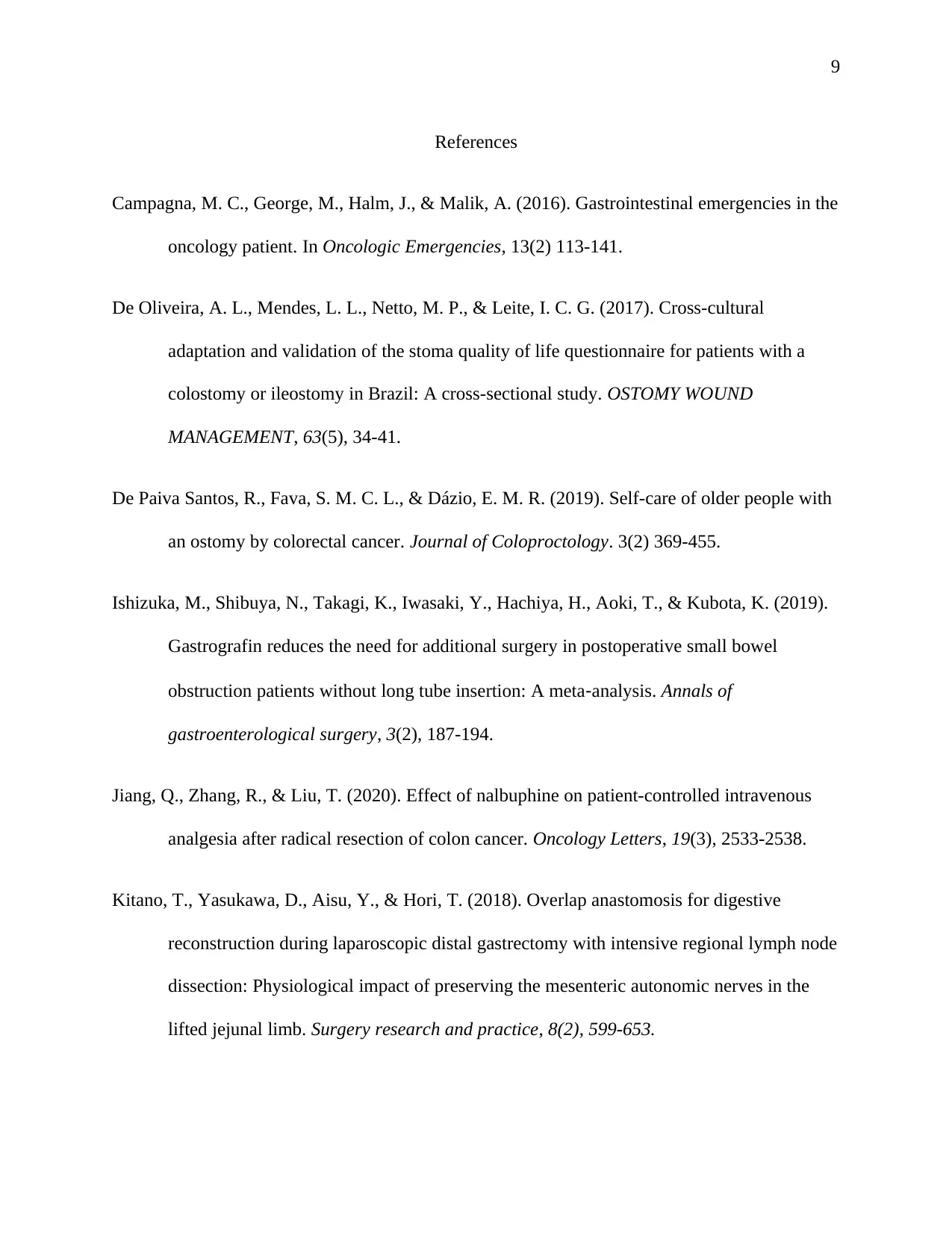
9
References
Campagna, M. C., George, M., Halm, J., & Malik, A. (2016). Gastrointestinal emergencies in the
oncology patient. In Oncologic Emergencies, 13(2) 113-141.
De Oliveira, A. L., Mendes, L. L., Netto, M. P., & Leite, I. C. G. (2017). Cross-cultural
adaptation and validation of the stoma quality of life questionnaire for patients with a
colostomy or ileostomy in Brazil: A cross-sectional study. OSTOMY WOUND
MANAGEMENT, 63(5), 34-41.
De Paiva Santos, R., Fava, S. M. C. L., & Dázio, E. M. R. (2019). Self-care of older people with
an ostomy by colorectal cancer. Journal of Coloproctology. 3(2) 369-455.
Ishizuka, M., Shibuya, N., Takagi, K., Iwasaki, Y., Hachiya, H., Aoki, T., & Kubota, K. (2019).
Gastrografin reduces the need for additional surgery in postoperative small bowel
obstruction patients without long tube insertion: A meta‐analysis. Annals of
gastroenterological surgery, 3(2), 187-194.
Jiang, Q., Zhang, R., & Liu, T. (2020). Effect of nalbuphine on patient-controlled intravenous
analgesia after radical resection of colon cancer. Oncology Letters, 19(3), 2533-2538.
Kitano, T., Yasukawa, D., Aisu, Y., & Hori, T. (2018). Overlap anastomosis for digestive
reconstruction during laparoscopic distal gastrectomy with intensive regional lymph node
dissection: Physiological impact of preserving the mesenteric autonomic nerves in the
lifted jejunal limb. Surgery research and practice, 8(2), 599-653.
References
Campagna, M. C., George, M., Halm, J., & Malik, A. (2016). Gastrointestinal emergencies in the
oncology patient. In Oncologic Emergencies, 13(2) 113-141.
De Oliveira, A. L., Mendes, L. L., Netto, M. P., & Leite, I. C. G. (2017). Cross-cultural
adaptation and validation of the stoma quality of life questionnaire for patients with a
colostomy or ileostomy in Brazil: A cross-sectional study. OSTOMY WOUND
MANAGEMENT, 63(5), 34-41.
De Paiva Santos, R., Fava, S. M. C. L., & Dázio, E. M. R. (2019). Self-care of older people with
an ostomy by colorectal cancer. Journal of Coloproctology. 3(2) 369-455.
Ishizuka, M., Shibuya, N., Takagi, K., Iwasaki, Y., Hachiya, H., Aoki, T., & Kubota, K. (2019).
Gastrografin reduces the need for additional surgery in postoperative small bowel
obstruction patients without long tube insertion: A meta‐analysis. Annals of
gastroenterological surgery, 3(2), 187-194.
Jiang, Q., Zhang, R., & Liu, T. (2020). Effect of nalbuphine on patient-controlled intravenous
analgesia after radical resection of colon cancer. Oncology Letters, 19(3), 2533-2538.
Kitano, T., Yasukawa, D., Aisu, Y., & Hori, T. (2018). Overlap anastomosis for digestive
reconstruction during laparoscopic distal gastrectomy with intensive regional lymph node
dissection: Physiological impact of preserving the mesenteric autonomic nerves in the
lifted jejunal limb. Surgery research and practice, 8(2), 599-653.
⊘ This is a preview!⊘
Do you want full access?
Subscribe today to unlock all pages.

Trusted by 1+ million students worldwide
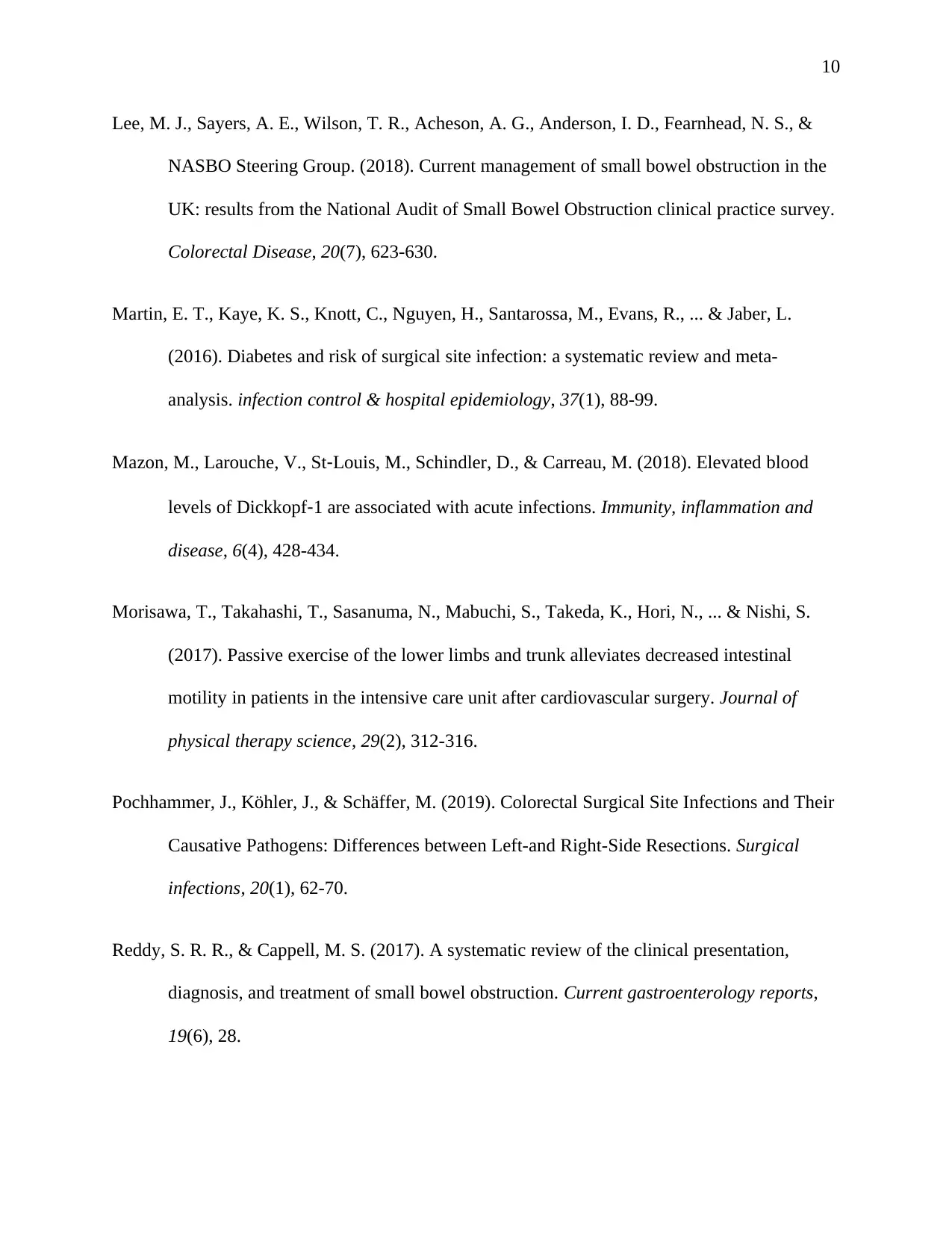
10
Lee, M. J., Sayers, A. E., Wilson, T. R., Acheson, A. G., Anderson, I. D., Fearnhead, N. S., &
NASBO Steering Group. (2018). Current management of small bowel obstruction in the
UK: results from the National Audit of Small Bowel Obstruction clinical practice survey.
Colorectal Disease, 20(7), 623-630.
Martin, E. T., Kaye, K. S., Knott, C., Nguyen, H., Santarossa, M., Evans, R., ... & Jaber, L.
(2016). Diabetes and risk of surgical site infection: a systematic review and meta-
analysis. infection control & hospital epidemiology, 37(1), 88-99.
Mazon, M., Larouche, V., St‐Louis, M., Schindler, D., & Carreau, M. (2018). Elevated blood
levels of Dickkopf‐1 are associated with acute infections. Immunity, inflammation and
disease, 6(4), 428-434.
Morisawa, T., Takahashi, T., Sasanuma, N., Mabuchi, S., Takeda, K., Hori, N., ... & Nishi, S.
(2017). Passive exercise of the lower limbs and trunk alleviates decreased intestinal
motility in patients in the intensive care unit after cardiovascular surgery. Journal of
physical therapy science, 29(2), 312-316.
Pochhammer, J., Köhler, J., & Schäffer, M. (2019). Colorectal Surgical Site Infections and Their
Causative Pathogens: Differences between Left-and Right-Side Resections. Surgical
infections, 20(1), 62-70.
Reddy, S. R. R., & Cappell, M. S. (2017). A systematic review of the clinical presentation,
diagnosis, and treatment of small bowel obstruction. Current gastroenterology reports,
19(6), 28.
Lee, M. J., Sayers, A. E., Wilson, T. R., Acheson, A. G., Anderson, I. D., Fearnhead, N. S., &
NASBO Steering Group. (2018). Current management of small bowel obstruction in the
UK: results from the National Audit of Small Bowel Obstruction clinical practice survey.
Colorectal Disease, 20(7), 623-630.
Martin, E. T., Kaye, K. S., Knott, C., Nguyen, H., Santarossa, M., Evans, R., ... & Jaber, L.
(2016). Diabetes and risk of surgical site infection: a systematic review and meta-
analysis. infection control & hospital epidemiology, 37(1), 88-99.
Mazon, M., Larouche, V., St‐Louis, M., Schindler, D., & Carreau, M. (2018). Elevated blood
levels of Dickkopf‐1 are associated with acute infections. Immunity, inflammation and
disease, 6(4), 428-434.
Morisawa, T., Takahashi, T., Sasanuma, N., Mabuchi, S., Takeda, K., Hori, N., ... & Nishi, S.
(2017). Passive exercise of the lower limbs and trunk alleviates decreased intestinal
motility in patients in the intensive care unit after cardiovascular surgery. Journal of
physical therapy science, 29(2), 312-316.
Pochhammer, J., Köhler, J., & Schäffer, M. (2019). Colorectal Surgical Site Infections and Their
Causative Pathogens: Differences between Left-and Right-Side Resections. Surgical
infections, 20(1), 62-70.
Reddy, S. R. R., & Cappell, M. S. (2017). A systematic review of the clinical presentation,
diagnosis, and treatment of small bowel obstruction. Current gastroenterology reports,
19(6), 28.
1 out of 10
Related Documents
Your All-in-One AI-Powered Toolkit for Academic Success.
+13062052269
info@desklib.com
Available 24*7 on WhatsApp / Email
![[object Object]](/_next/static/media/star-bottom.7253800d.svg)
Unlock your academic potential
Copyright © 2020–2025 A2Z Services. All Rights Reserved. Developed and managed by ZUCOL.





